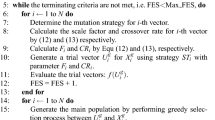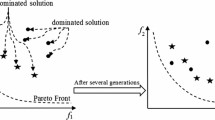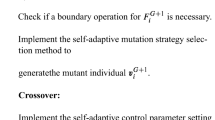Abstract
Considering that the model of the \(p\)-Xylene (PX) oxidation reaction process is a hybrid and highly nonlinear model, a differential evolution algorithm with self-adaptive mutation strategy and control parameters (SSCPDE) was proposed to optimize the operating conditions. In SSCPDE, each individual has its own control parameters and mutation strategies that can be self-adaptively adjusted to different evolution phases and various optimization problems. SSCPDE was compared with 6 state-of-the-art DE variants by 38 different types of benchmark functions. Simulation results show that the average performance of SSCPDE is better than the six famous self-adaptive DE algorithms. Finally, the SSCPDE algorithm was used to optimize the five main operating conditions of the PX oxidation reaction process. Optimization results indicate that the production cost, loss of acetic acid and PX combustion of the PX oxidation reaction process are greatly reduced and that SSCPDE performs better than JADE, EPSDE, SaDE, and the optimizer of Aspen Plus and similar to jDE and CoDE.










Similar content being viewed by others
References
Abbass HA (2002) The self-adaptive pareto differential evolution algorithm. In: Proceedings of the 2002 congress on evolutionary computation, pp 831–836
Babu B, Jehan MML (2003) Differential evolution for multi-objective optimization. In: IEEE congress on evolutionary computation, pp 2696–2703
Brest J, Greiner S, Boskovic B, Mernik M, Zumer V (2006) Self-adapting control parameters in differential evolution: a comparative study on numerical benchmark problems. IEEE Trans Evol Comput 10(6):646–657
Brest J, Maučec MS (2008) Population size reduction for the differential evolution algorithm. Appl Intell 29(3):228–247
Chiou JP, Chang CF, Su CT (2005) Variable scaling hybrid differential evolution for solving network reconfiguration of distribution systems. IEEE Trans Power Syst 20(2):668–674
Cincotti A, Orrù R, Cao G (1999) Kinetics and related engineering aspects of catalytic liquid-phase oxidation of p-xylene to terephthalic acid. Catal Today 52(2):331–347
Das S, Suganthan PN (2011) Differential evolution: a survey of the state-of-the-art. IEEE Trans Evol Comput 15(1):4–31
Eiben AE, Hinterding R, Michalewicz Z (1999) Parameter control in evolutionary algorithms. IEEE Trans Evol Comput 3(2):124–141
Gämperle R, Müller SD, Koumoutsakos P (2002) A parameter study for differential evolution. Adv Intell Syst Fuzzy Syst Evolut Comput 10:293–298
D-z Geng, Chen X, Shao Z-j, Qian J-x (2006) Interface between MATLAB and Aspen Plus based on COM technology and its advanced application. Control Instrum Chem Ind 33(3):30
Ghosh A, Das S, Chowdhury A, Giri R (2011) An improved differential evolution algorithm with fitness-based adaptation of the control parameters. Inf Sci 181(18):3749–3765
Gong W, Cai Z, Ling CX, Li H (2011) Enhanced differential evolution with adaptive strategies for numerical optimization. IEEE T Syst Man Cy B 41(2):397–413
Hanotier J, Hanotier-Bridoux M (1981) Mechanism of the liquid phase homogeneous oxidation of alkylaromatic hydrocarbons by cobalt salts. J Mol Catal 12(2):133–147
Hong H, Wenli D, Feng Q, Weimin Z (2010) Operation condition optimization of p-xylene oxidation reaction process based on a fuzzy adaptive immune algorithm. Ind Eng Chem Res 49(12):5683–5693
Kleerebezem R, Lettinga G (2000) High-rate anaerobic treatment of purified terephthalic acid wastewater. Water Sci Technol 42(5–6):259–268
Liu J, Lampinen J (2005) A fuzzy adaptive differential evolution algorithm. Soft Comput 9(6):448–462
Mallipeddi R, Suganthan P, Pan Q, Tasgetiren M (2011) Differential evolution algorithm with ensemble of parameters and mutation strategies. Appl Soft Comput 11(2):1679–1696
Mininno E, Neri F, Cupertino F, Naso D (2011) Compact differential evolution. IEEE Trans Evol Comput 15(1):32–54
Mu S, Su H, Gu Y, Chu J (2003) Multi-objective optimization of industrial purified terephthalic acid oxidation process. Chin J Chem Eng 11(5):536–541
Neri F, Iacca G, Mininno E (2011) Disturbed exploitation compact differential evolution for limited memory optimization problems. Inf Sci 181(12):2469–2487
Neri F, Mininno E (2010) Memetic compact differential evolution for cartesian robot control. IEEE Comput Intell M 5(2):54–65
Neri F, Tirronen V (2010) Recent advances in differential evolution: a survey and experimental analysis. Artif Intell Rev 33(1–2):61–106
Omran Mahamed GH, Salman A (2009) Constrained optimization using CODEQ. Chaos, Solitons Fractals 42:662–668
Pan Q-K, Suganthan P, Wang L, Gao L, Mallipeddi R (2011) A differential evolution algorithm with self-adapting strategy and control parameters. Comput Oper Res 38(1):394–408
Partenheimer W (1995) Methodology and scope of metal/bromide autoxidation of hydrocarbons. Catal Today 23(2):69–158
Price KV (1997) Differential evolution vs. the functions of the 2nd ICEO. In: IEEE congress on evolutionary computation, pp 153–157
Price KV (1999) An introduction to differential evolution. In: New ideas in optimization. McGraw-Hill Ltd., UK, pp 79–108
Qin A, Huang V, Suganthan P (2009) Differential evolution algorithm with strategy adaptation for global numerical optimization. IEEE Trans Evol Comput 13(2):398–417
Raghavendrachar P, Ramachandran S (1992) Liquid-phase catalytic oxidation of p-xylene. Ind Eng Chem Res 31(2):453–462
Renon H, Prausnitz JM (1968) Local compositions in thermodynamic excess functions for liquid mixtures. AIChE J 14(1):135–144
Ronkkonen J, Kukkonen S, Price KV (2005) Real-parameter optimization with differential evolution. In: IEEE congress on evolutionary computation, pp 506–513
Soliman OS, Bui LT (2008) A self-adaptive strategy for controlling parameters in differential evolution. In: IEEE congress on evolutionary computation, pp 2837–2842
Soliman OS, Bui LT, Abbass HA (2007) The effect of a stochastic step length on the performance of the differential evolution algorithm. In: IEEE congress on evolutionary computation, pp 2850–2857
Storn R, Price K (1995) Differential Evolution-a simple and efficient adaptive scheme for global optimization over continuous spaces. International Computer Science Institute, Berkeley, CA, 1995, Tech. Rep. TR-95-012
Storn R, Price K (1997) Differential evolution—a simple and efficient heuristic for global optimization over continuous spaces. J Global Optim 11(4):341–359
Suganthan PN et al (2005) Problem definitions and evaluation criteria for the CEC 2005 special session on real-parameter optimization. KanGAL, Report 2005005
Teng NS, Teo J, Hijazi MHA (2009) Self-adaptive population sizing for a tune-free differential evolution. Soft Comput 13(7):709–724
Teo J (2006) Exploring dynamic self-adaptive populations in differential evolution. Soft Comput 10(8):673–686
Wang Y, Cai Z, Zhang Q (2011) Differential evolution with composite trial vector generation strategies and control parameters. IEEE Trans Evol Comput 15(1):55–66
Xu Y, Zhu Q (2008) Research and implementation of decreasing the acetic acid consumption in purified terephthalic acid solvent system. Chin J Chem Eng 16(4):650–655
Yan XF, Yu J, Qian F (2005) Development of an artifical neural network model for combustion reaction in p-xylene oxidation reactor. Polyest Ind 1:004
Yan X, Chen D, Hu S, Ding J (2002) Estimation of kinetic parameters using chaos genetic algorithms. J Chem Ind Eng 53(8):810–814
Yan X, Du W, Qian F (2004) Development of a kinetic model for industrial oxidation of p-xylene by RBF-PLS and CCA. AIChE J 50(6):1169–1176
Zaharie D (2002) Critical values for the control parameters of differential evolution algorithms. In: Proceedings of MENDEL, pp 62–67
Zamuda A, Brest J (2012) Population reduction differential evolution with multiple mutation strategies in real world industry challenges Swarm and Evolutionary Computation. Springer, Berlin, pp 154–161
Zamuda A, Brest J, Bošković B, Žumer V (2011) Differential evolution for parameterized procedural woody plant models reconstruction. Appl Soft Comput 11(8):4904–4912
Zhang J, Sanderson AC (2009) JADE: adaptive differential evolution with optional external archive. IEEE Trans Evol Comput 13(5):945–958
Zhong Y, Zhang L (2012) Remote sensing image subpixel mapping based on adaptive differential evolution. IEEE T Syst Man Cy B 42(5):1306–1329
Acknowledgments
The authors gratefully acknowledge the support from the following foundations: 973 project of China (2013CB733600), National Natural Science Foundation of China (21176073) and the Fundamental Research Funds for the Central Universities. Meanwhile, the authors would like to thank Dr. Zhang, Dr. Brest, Dr. Mallipeddi, Dr. Wang, and Dr. Suganthan for providing the source codes of JADE, jDE, EPSDE, CoDE, and SaDE, respectively, and Dr. Xi Chen, who is a professor of Zhejiang University and very kind to freely provide the MAP interface toolbox for us.
Author information
Authors and Affiliations
Corresponding author
Additional information
Communicated by V. Loia.
Appendix
Appendix
10 a.m. on the July 16, 2009 | |||||
|---|---|---|---|---|---|
Operating conditions of reactor (D1-301) | |||||
HAC (%wt) | Pressure (MPag) | Drainage flowrate (T/h) | H2O (%wt) | ||
73.75 | 1.41 | 58 | 6.95 | ||
10 a.m. on the July 16, 2009 | |||||
|---|---|---|---|---|---|
Operation conditions of the first crystallizer (D1-401) | |||||
Temperature (\(^{\circ }\)C) | Level (%) | Total volume (m\(^{3}\)) | Pressure (MPag) | ||
187.26 | 57.72 | 135 | 1.1 | ||
10 a.m. on the July 16, 2009 | |||||
|---|---|---|---|---|---|
Operation conditions of the first heater (E1-304) | Operation conditions of the second heater (E1-305) | ||||
Temperature (\(^{\circ }\)C) | Pressure (MPag) | Temperature (\(^{\circ }\)C) | Pressure (MPag) | ||
158 | 1.43 | 136 | 1.42 | ||
5 a.m. on the July 8, 2009 | |||||
|---|---|---|---|---|---|
Operating conditions of reactor (D1-301) | |||||
HAC (%wt) | Pressure (MPag) | Drainage flowrate (T/h) | H2O (%wt) | ||
73.48 | 1.425 | 58 | 6.08 | ||
5 a.m. on the July 8, 2009 | |||||
|---|---|---|---|---|---|
Operation conditions of the first crystallizer (D1-401) | |||||
Temperature (\(^{\circ }\)C) | Level (%) | Total volume (m\(^{3}\)) | Pressure (MPag) | ||
187.12 | 60.74 | 135 | 1.1 | ||
5 a.m. on the July 8, 2009 | |||||
|---|---|---|---|---|---|
Operation conditions of the first heater (E1-304) | Operation conditions of the second heater (E1-305) | ||||
Temperature (\(^{\circ }\)C) | Pressure (MPag) | Temperature (\(^{\circ }\)C) | Pressure (MPag) | ||
157 | 1.43 | 137 | 1.42 | ||
10 a.m. on the July 16, 2009 | |||||
|---|---|---|---|---|---|
Operating conditions of reactor (D1-301) | Yield | ||||
Content of PX (%wt) | Mixed feed (T/h) | Inlet flowrate of air (T/h) | Total reactor volume (m\(^{3}\)) | Flowrate of wastegas (kmol/h) | CTA (kg/h) |
15.5 | 200.88 | 147.12 | 501 | 4392.56 | 45642.55 |
Operation conditions of the second crystallizer (D1-402) | Operation conditions of the third crystallizer (D1-403) | ||||
|---|---|---|---|---|---|
Temperature (\(^{\circ }\)C) | Pressure (MPag) | Total volume (m\(^{3}\)) | Temperature (\(^{\circ }\)C) | Pressure (MPag) | Total volume (m\(^{3}\)) |
156.1 | 0.27 | 135 | 92.05 | \(-0.56\) | 155 |
10 a.m. on the July 16, 2009 | |||||
|---|---|---|---|---|---|
Operation conditions of the third heater (E1-306) | Operation conditions of the fourth heater (E1-307) | ||||
Temperature (\(^{\circ }\)C) | Pressure (MPag) | Temperature (\(^{\circ }\)C) | Pressure (MPag) | ||
80 | 1.42 | 24 | 1.41 | ||
5 a.m. on the July 8, 2009 | |||||
|---|---|---|---|---|---|
Operating conditions of reactor (D1-301) | Yield | ||||
Content of PX (%wt) | Mixed feed (T/h) | Inlet flowrate of air (T/h) | Total reactor volume (m\(^{3}\)) | Flowrate of wastegas (kmol/h) | CTA (kg/h) |
15.5 | 201.06 | 147.25 | 501 | 4446.65 | 46249.56 |
5 a.m. on the July 8, 2009 | |||||
|---|---|---|---|---|---|
Operation conditions of the second crystallizer (D1-402) | Operation conditions of the third crystallizer (D1-403) | ||||
Temperature (\(^{\circ }\)C) | Pressure (MPag) | Total volume (m\(^{3}\)) | Temperature (\(^{\circ }\)C) | Pressure (MPag) | Total volume (m\(^{3}\)) |
156.4 | 0.28 | 135 | 92.19 | \(-0.55\) | 155 |
5 a.m. on the July 8, 2009 | |||||
|---|---|---|---|---|---|
Operation conditions of the third heater (E1-306) | Operation conditions of the fourth heater (E1-307) | ||||
Temperature (\(^{\circ }\)C) | Pressure (MPag) | Temperature (\(^{\circ }\)C) | Pressure (MPag) | ||
81 | 1.42 | 23 | 1.41 | ||
Rights and permissions
About this article
Cite this article
Fan, Q., Yan, X. Differential evolution algorithm with self-adaptive strategy and control parameters for P-xylene oxidation process optimization. Soft Comput 19, 1363–1391 (2015). https://doi.org/10.1007/s00500-014-1349-y
Published:
Issue Date:
DOI: https://doi.org/10.1007/s00500-014-1349-y




